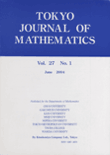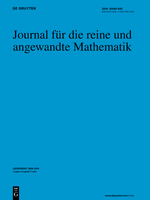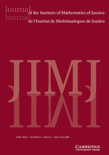
Tunisian Journal of Mathematics
Scope & Guideline
Connecting Scholars to Shape the Future of Mathematics.
Introduction
Aims and Scopes
- Algebraic Geometry and Topology:
The journal frequently publishes works related to algebraic structures, including Hodge theory, moduli spaces, and homological methods, reflecting a strong focus on the interplay between geometry and algebra. - Analysis and Partial Differential Equations:
A significant portion of the journal's articles delve into various analytical techniques, particularly in the study of partial differential equations, including Sobolev spaces, nonlinear Schrödinger equations, and fluid dynamics. - Representation Theory and Algebraic Structures:
Research in representation theory, particularly concerning p-adic groups and operads, is prominently featured, showcasing the journal's commitment to exploring algebraic structures in depth. - Mathematical Physics:
The journal includes papers that bridge mathematics and physics, particularly in areas such as statistical mechanics, dynamical systems, and the study of integrable systems, indicating a broad interdisciplinary approach. - Combinatorics and Probability:
The publication of works in combinatorial mathematics and probability theory, including random walks and statistical ensembles, indicates a growing interest in these areas.
Trending and Emerging
- Nonlinear Dynamics and Fluid Mechanics:
An increasing number of papers focus on nonlinear dynamics, particularly in relation to fluid mechanics, showcasing the journal's engagement with contemporary issues in applied mathematics. - Algebraic Structures in Modern Contexts:
There is a trend towards exploring algebraic structures, such as Tambara functors and operads, in modern mathematical contexts, reflecting a growing interest in higher algebra. - Geometric Analysis and Differential Geometry:
Emerging themes in geometric analysis, particularly with respect to Higgs bundles and K3 surfaces, indicate a revitalization of interest in differential geometry within the journal. - Mathematical Aspects of Statistical Physics:
The intersection of mathematics and statistical physics is increasingly represented, with papers addressing topics such as Ising systems and probabilistic models, pointing to a trend in interdisciplinary research. - Homotopy Theory and Higher Categories:
Recent works in homotopy theory and the study of higher categories demonstrate an emerging focus on foundational aspects of mathematics, signaling a shift towards more abstract and categorical approaches.
Declining or Waning
- Classical Number Theory:
There has been a noticeable decrease in papers focused on classical number theory topics, suggesting a shift towards more modern and applied areas of mathematics. - Elementary Geometry:
The frequency of publications related to elementary geometric concepts and problems has diminished, indicating that the journal may be prioritizing more complex and abstract mathematical inquiries. - Discrete Mathematics:
Although still relevant, topics in discrete mathematics, such as graph theory and combinatorial optimization, are appearing less frequently in recent issues compared to previous years. - Mathematical Education:
Research focused on pedagogical methods and mathematical education is less represented in newer volumes, suggesting a potential shift away from educational aspects in favor of pure research. - Computational Mathematics:
While computational methods remain important, there is a noticeable decline in the number of papers dedicated to numerical analysis and computational techniques, indicating a possible trend towards theoretical advancements.
Similar Journals

TRANSACTIONS OF THE AMERICAN MATHEMATICAL SOCIETY
Advancing Mathematical Frontiers Since 1900TRANSACTIONS OF THE AMERICAN MATHEMATICAL SOCIETY, published by the American Mathematical Society, is a premier journal in the field of mathematics that has been contributing to the advancement of mathematical knowledge since 1900. With an ISSN of 0002-9947 and an E-ISSN of 1088-6850, this journal holds a prestigious position in the academic landscape, evidenced by its Q1 rankings in both Applied Mathematics and Miscellaneous Mathematics categories as of 2023. With a Scopus ranking of #97 in General Mathematics and a percentile standing of 75th, the journal is recognized for its rigorous peer-review process and the quality of the research it publishes. Though it does not currently offer open access options, it essentially serves as a vital resource for researchers, professionals, and students seeking critical insights and developments in mathematical theory and applications. The Transactions aim to publish high-quality research articles that foster the exchange and dissemination of ideas, supporting the growth of both theoretical and applied mathematics within the global scholarly community.

Forum of Mathematics Sigma
Connecting scholars through open access to cutting-edge research.Forum of Mathematics Sigma is a premier open access journal published by Cambridge University Press that has been at the forefront of mathematical research since its inception in 2013. With a strong emphasis on advancing the fields of mathematics, the journal consistently achieves Q1 rankings across multiple categories, including Algebra and Number Theory, Analysis, and Computational Mathematics. This distinction highlights its impact and relevance within the scholarly community. The journal prides itself on providing a platform for innovative research, fostering collaboration among researchers and practitioners across various mathematical disciplines. Open access publication ensures that cutting-edge findings are widely available to readers globally, enhancing the dissemination of knowledge. With an address in the heart of Cambridge, England, Forum of Mathematics Sigma is dedicated to promoting high-quality research and making significant contributions to the development of mathematics.

ANNALS OF MATHEMATICS
Connecting Theory and Application in MathematicsANNALS OF MATHEMATICS is a prestigious peer-reviewed journal published by the Department of Mathematics at Princeton University, dedicated to the advancement of mathematical research across diverse fields, including mathematics, statistics, and probability. With an impressive impact factor reflecting its critical role in the academic community, this journal is categorized within the Q1 quartile rankings for both Mathematics and Statistics in 2023, evidencing its high circulation of influential and often-cited publications. Researchers can access the latest findings and theoretical advancements in an environment that fosters intellectual discourse and innovation, although the journal does not currently offer open access. Spanning a remarkable convergence period from 1996 to 2024, the ANNALS OF MATHEMATICS serves as a vital resource for mathematicians, statisticians, and analysts striving to push the boundaries of knowledge and application in these critical fields.

Bulletin Mathematique de la Societe des Sciences Mathematiques de Roumanie
Empowering Researchers with Rigorous Mathematical InsightsThe Bulletin Mathematique de la Societe des Sciences Mathematiques de Roumanie, published by SOC MATEMATICE ROMANIA, is a distinguished platform dedicated to the dissemination of advanced mathematical research and developments. With ISSN 1220-3874 and E-ISSN 2065-0264, this journal serves the global mathematical community, particularly in Romania, fostering collaboration and innovation in varied mathematical disciplines. Despite being categorized in the Q3 quartile of the *Mathematics (miscellaneous)* field and holding a Scopus rank placing it in the 19th percentile, the journal remains committed to publishing high-quality articles that explore theoretical and applied mathematics. Running from 2008 to 2024, it aims to encourage the sharing of knowledge and advancements within both academic and practical domains, affirming its importance as a valuable resource for researchers, professionals, and students alike. Although the journal does not currently offer open access, it contributes to the mathematical discourse through the rigorous selection of papers that adhere to high scholarly standards.

Tokyo Journal of Mathematics
Cultivating Excellence in Mathematical ResearchTokyo Journal of Mathematics is a prestigious journal dedicated to the dissemination of high-quality research in the field of mathematics. Founded in 1978, this journal serves as a platform for researchers to publish their findings, providing cutting-edge insights into various mathematical theories and applications. Published by the TOKYO JOURNAL MATHEMATICS EDITORIAL OFFICE ACAD CENTER, the journal is based in Japan and forms an integral part of the global mathematical community. Although listed in the Q4 quartile of Mathematics (Miscellaneous) category for 2023, its inclusion in Scopus rankings highlights its ongoing commitment to scholarly excellence. The journal does not currently offer Open Access options, thus providing readers with insightful access to critical advancements in mathematics. With an ISSN of 0387-3870 and a publication history spanning over four decades, the Tokyo Journal of Mathematics remains an essential resource for researchers, professionals, and students alike, fostering the advancement of mathematical knowledge and collaboration across borders.

JOURNAL OF THE KOREAN MATHEMATICAL SOCIETY
Fostering innovation in mathematics, one article at a time.JOURNAL OF THE KOREAN MATHEMATICAL SOCIETY is a premier academic publication dedicated to advancing the field of mathematics through rigorous research and scholarly discourse. Published by the esteemed Korean Mathematical Society, this journal provides a platform for mathematicians and researchers to disseminate their findings, engage in innovative ideas, and connect with the global mathematical community. With an ISSN of 0304-9914 and E-ISSN 2234-3008, the journal has established itself as an important resource in the mathematical landscape, currently holding a Q3 classification in the ‘Mathematics (miscellaneous)’ category as per the 2023 rankings. Though not open access, the journal is committed to promoting high-quality contributions that span various mathematical disciplines, making it indispensable for students, researchers, and professionals alike. Operating from its base in Seoul, South Korea, it contributes to the international mathematics community by publishing cutting-edge research from 1997 to 2024 and beyond, facilitating an avenue for knowledge sharing and innovation in mathematics.

Kyoto Journal of Mathematics
Advancing mathematical frontiers with groundbreaking research.Kyoto Journal of Mathematics is a premier academic publication dedicated to advancing the field of mathematics, published by DUKE UNIVERSITY PRESS. Established in 1996, this journal serves as a vital platform for sharing innovative research and breakthrough studies across various mathematical disciplines. The journal has consistently maintained a prestigious Q1 ranking in the category of Mathematics (miscellaneous) as of 2023, reflecting its significant impact and contribution to the mathematical community. With its Open Access policy, the Kyoto Journal of Mathematics ensures that groundbreaking research is easily accessible to a global audience, fostering collaboration and knowledge dissemination among researchers, professionals, and students alike. The journal's commitment to excellence and relevance in mathematical research is underscored by its extensive archive of published works and its continuous engagement with contemporary mathematical challenges. This makes the journal an essential resource for anyone seeking to stay abreast of current trends and advancements in the field.

JOURNAL FUR DIE REINE UND ANGEWANDTE MATHEMATIK
Exploring Pure and Applied Mathematics with PrecisionJOURNAL FUR DIE REINE UND ANGEWANDTE MATHEMATIK is a prestigious publication in the field of mathematics, established in 1826 and proudly published by WALTER DE GRUYTER GMBH, a respected name in academic publishing. Renowned for its rigorous peer-review process, this journal focuses on both pure and applied mathematics, making significant contributions to various mathematical domains. With an impressive impact factor positioning it in the Q1 quartile for both applied mathematics and miscellaneous mathematics categories, the journal ranks 83rd out of 399 in General Mathematics and 282nd out of 635 in Applied Mathematics according to Scopus. The journal does not currently offer open access options but is widely available through institutional subscriptions. Its rich history and ongoing commitment to excellence position the JOURNAL FUR DIE REINE UND ANGEWANDTE MATHEMATIK as an essential resource for researchers, professionals, and students aiming to stay abreast of the latest developments in mathematical theory and practice.

JOURNAL OF THE EUROPEAN MATHEMATICAL SOCIETY
Fostering Collaboration in Mathematical ExcellenceThe JOURNAL OF THE EUROPEAN MATHEMATICAL SOCIETY, published by the EUROPEAN MATHEMATICAL SOCIETY (EMS), stands as a premier platform in the field of mathematics, known for its rigorous editorial standards and impactful contributions to both applied and theoretical aspects of the discipline. With a commendable Q1 ranking in both Applied Mathematics and Miscellaneous Mathematics categories, alongside a Scopus rank of 32 out of 399 in General Mathematics, this journal has established itself as a crucial resource for researchers and professionals. Since achieving Open Access status in 2021, it has expanded its reach, making cutting-edge research more accessible to a global audience. With a publication horizon extending from 2002 to 2024 and a dedicated focus on high-quality mathematical scholarship, the journal continues to foster innovation and collaboration within the mathematical community.

Journal of the Institute of Mathematics of Jussieu
Elevating the Standards of Mathematical ScholarshipJournal of the Institute of Mathematics of Jussieu, published by Cambridge University Press, is a leading academic journal that has established itself as a vital resource in the field of mathematics. With an impressive impact factor and a ranking in the top quartile (Q1) of miscellaneous mathematics, the journal serves as a platform for high-quality research from both established scholars and emerging researchers. Spanning from 2002 to 2024, the journal aims to foster collaboration and innovation in the mathematical community by publishing original research articles, reviews, and critical discussions on a wide range of mathematical topics. Although the journal does not offer open access, it remains widely accessible through various academic institutions and libraries, ensuring that critical advancements in mathematics are shared with a global audience. Located in the United Kingdom at the prestigious Cambridge campus, the journal reflects the rigorous standards of its publisher and the rich academic tradition of its home institution.